Journalists@Work: Sophia Chinyezi
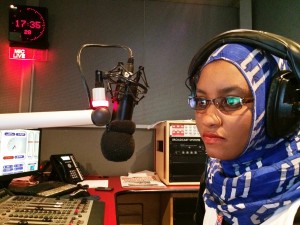 Sophia Chinyezi works as a radio journalist and news reader at Radio Maisha in Nairobi. The station broadcasts across Kenya in Kiswahili and is owned by the Standard Media Group. Sophia has been working at Radio Maisha for three years and holds a diploma in broadcast journalism.
Sophia Chinyezi works as a radio journalist and news reader at Radio Maisha in Nairobi. The station broadcasts across Kenya in Kiswahili and is owned by the Standard Media Group. Sophia has been working at Radio Maisha for three years and holds a diploma in broadcast journalism.
The 26-year-old reporter says writing and journalism is in the family. She was inspired to pursue a career in journalism and broadcasting by her grandfather who was a well-known poet and newspaper editor, and by her aunt, Saumu Mwasimba, who currently works in Deutsche Welle’s Kiswahili service. A recent highlight for Sophia was traveling to South Korea to produce a feature comparing South Korean and Kenyan economic development. Sophia spoke to onMedia about her work.
![]() read more
read more
Must-Read Research Papers for Journalism Trainers
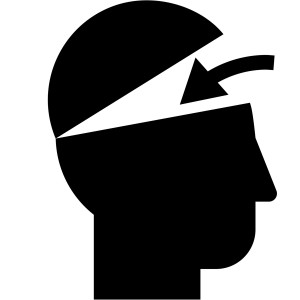 Journalism training and media development have evolved into a huge sector. It spans international development agencies, public, private and community media, NGOs, civil society groups, foundations, academia and private contractors. As a trainer, even if you have considerable experience, there’s a risk of concentrating on simply implementing the specific learning objectives of your next workshop without giving thought to the bigger picture or taking into consideration some of the findings from research into media development.
Journalism training and media development have evolved into a huge sector. It spans international development agencies, public, private and community media, NGOs, civil society groups, foundations, academia and private contractors. As a trainer, even if you have considerable experience, there’s a risk of concentrating on simply implementing the specific learning objectives of your next workshop without giving thought to the bigger picture or taking into consideration some of the findings from research into media development.
Here’s what I mean. An article in the Economist magazine back in 2007 spoke of a boom in journalism training in developing countries. The article raised a number of points that should grab the attention of any journalism trainer or project manager:
“The need for basic reporting skills is still central.”
“Participants in the courses praise the results, while complaining about the lack of focus and co-ordination among some providers.”
“More is not always better. Quality varies wildly.”
“Some courses aspire loftily to build democratic societies through a free press.”
Seven years on, some of those points might sound familiar to you or even appear on your course evaluation forms. So whether you’re training journalists or working in other areas related to media development such as press freedom, community media, access to information or digital innovation, it would be worth reading the recently published research papers below.
Perhaps just as important, we can continue to ask ourselves: what’s working?, what’s not working?, and what more needs to be done in this field?
![]() read more
read more
Tools & Apps for Journalists: JamSnap
 Perhaps the easiest way to describe JamSnap is as an iPhone app that lets you make an interactive image by adding snippets of sound and then share it through social media. It will remind you of other apps, but JamSnap is a deceptively simple idea that lets you tell a short story. Think Instagram, but with an audio clip to provide more context or natural sound. Think Thinglink, but easier to produce. And while SoundCloud and Audioboo both allow you to attach photos to an audio clip, JamSnap lets you grab the interest of the audience with an image first. That’s probably going to be more attractive to mobile users.
Perhaps the easiest way to describe JamSnap is as an iPhone app that lets you make an interactive image by adding snippets of sound and then share it through social media. It will remind you of other apps, but JamSnap is a deceptively simple idea that lets you tell a short story. Think Instagram, but with an audio clip to provide more context or natural sound. Think Thinglink, but easier to produce. And while SoundCloud and Audioboo both allow you to attach photos to an audio clip, JamSnap lets you grab the interest of the audience with an image first. That’s probably going to be more attractive to mobile users.
![]() read more
read more
Myanmar’s ethnic media finding its voice, but faces hurdles
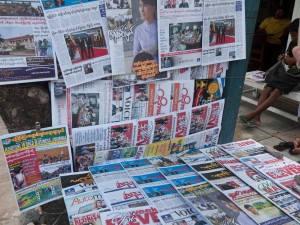
Myanmar’s media sector has opened up remarkably over the past few years (photo: Kyle James)
The country of Myanmar is a complicated patchwork of ethnic groups, languages and cultural identities. Ethnic conflict in the country, also known as Burma, existed even before independence in 1948 and increased under the iron-fisted military rule that began in 1962.
In addition, ethnic media was suppressed by the junta, which increased the sense of marginalization felt by over one-third of the population belonging to an ethnic minority.
But as the country has opened up over the past few years, ethnic media publications have begun to appear, speaking to their communities in their own languages and addressing issues relevant to them. Still, there are a good many hurdles in the way of the creation of a flourishing ethnic media sector, as onMedia’s Kyle James found during two recent trips to the Southeast Asian country.
![]() read more
read more
Getting online data to offline communities
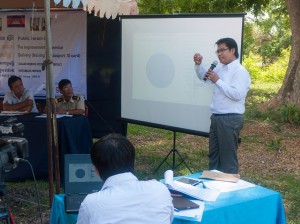
Bringing online data to a rural, offline community (photo: Kyle James)
Data journalism has opened up new ways of telling compelling stories, finding connections and creating visuals that explain important, complex issues is easy-to-understand ways.
This has become possible through the huge range of digital information now available online. While much of that information is presented online and sometimes in newspapers and magazines, what about communities who don’t have much access to the internet or even printed media?
Are these communities, often poor and rural, simply going to miss out on the results and benefits of data journalism? Not necessarily. onMedia’s Kyle James looks at a project in Cambodia that has been linking online and offline communities – with promising results.
![]() read more
read more
Choosing a tripod mount for your smartphone reporting kit
 Unlike most cameras, smartphones do not have a threaded hole to connect a tripod. So, a tripod mount is an essential part of a smartphone reporting kit.
Unlike most cameras, smartphones do not have a threaded hole to connect a tripod. So, a tripod mount is an essential part of a smartphone reporting kit.
It will allow you to not only attach your smartphone to a tripod but to literally anything that has a standard 1/4 inch thread camera mount. For example, a monopod, pistol-style hand grip or a flexible camera support system such as a Gorillapod or Dinkum grip.
The benefits are clear. Using some sort of supporting device to stabilize the smartphone will produce better shots, especially when recording video interviews.
I’ve tried tripod mounts of different shapes and sizes to fit the various mobile phones I’ve used. Some were rubbish, while others only worked with specific mobile phone models and become redundant when you changed phone.
Fortunately there is a trend now for manufacturers to offer tripod mounts that will fit different types of smartphones.
The criteria I usually follow is straightforward. Is it easy to adjust; is it robust and does it work with my other equipment?
![]() read more
read more
Tools and Apps for Journalists: iRig Recorder App
What is the iRig app?
These days, journalists with smart phones have a wide array of tools to use in their reporting. For those who need to record and send audio, the free iRig Recorder app for iOS and Android is worth checking out.
![]() read more
read more
What to wear reporting on camera
New TV journalists often wonder about the dos and don’ts of what to wear when reporting on camera. onMedia has compiled these tips from experienced DW TV reporters and news anchors Ben Fajzullin and Meggin Leigh.
DOS
Think about the background
The color of the background is important. You are going to disappear if you wear desert colors in a desert. Likewise, if you wear something dark at night, we will only see your head. In a studio, wearing green in front of a green screen or blue in front of a blue screen means your body disappears. By the way, red works better in front of a blue screen.
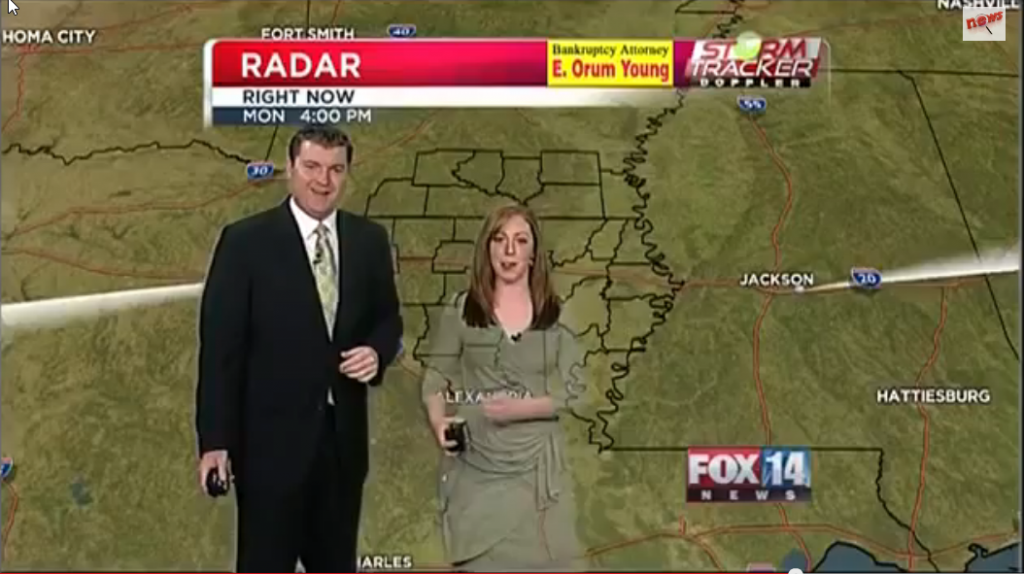
Notice how you can see the map behind the presenter through her clothes because she is wearing the same color as the screen behind her. You can watch the whole video here.
![]() read more
read more
Journalists@Work: Gary Hatigeva in the Solomon Islands
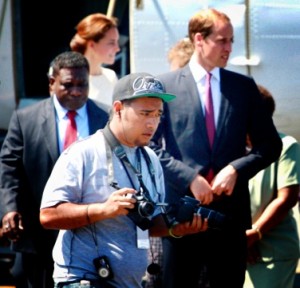
Gary covering a royal visit to the Solomon Islands
Environmental journalist Gary Scott Hatigeva lives in the Solomon Islands, a remote tropical country in the South Pacific about 2,000 km north-east of Australia. Much of the population of the Solomons lives in rural villages dispersed over hundreds of islands and many people still have little access to the media. For the past four years, Gary has worked as a reporter, photographer, online editor and graphic designer for The Island Sun, one of the two major newspapers in the Solomon Islands. During his day to day work, Gary is involved with the paper’s editing team, and on occasion stands in as assistant editor. He also takes photographs for the paper and edits them for publications. Gary wrote to onMedia about his work and journalism interests.
![]() read more
read more
Upgrade your camera with a WiFi memory card
 My smartphone has a fantastic camera and it’s a like a digital notebook for documenting events and sharing content, especially photos. But when I want to produce a better quality image, say a portrait of an interview partner, or when I want to work in low light conditions, then I’ll reach for my digital stills camera.
My smartphone has a fantastic camera and it’s a like a digital notebook for documenting events and sharing content, especially photos. But when I want to produce a better quality image, say a portrait of an interview partner, or when I want to work in low light conditions, then I’ll reach for my digital stills camera.
The question is: how do I make my SLR camera as “mobile” as my smartphone so I can transfer images quickly from the camera to another device and share them on the web?
Yes, I can use a USB cable to connect my camera to either my laptop or my iPad or take out the SD card and plug it directly into the computer. But another way is to use a WiFi enabled SD memory card and there are some interesting advantages of using these cards for covering events.
WiFi enabled SD cards have been around for a while now. The WiFi chip inside the card creates its own wireless network, which allows you to connect your camera via the SD card to another device.
In this post I’m going to refer to two Class 10 WiFi SD cards: the Eye-Fi mobi and the Toshiba FlashAir.
![]() read more
read more








